Introducing the Tamarins: Miniature New World Monkeys
Tamarins represent a captivating group of small New World monkeys, celebrated for their distinctive appearance and complex social lives. Found exclusively in the forests of Central and South America, these primates are characterized by their relatively small size, striking coloration, and, most famously, prominent facial whiskers resembling mustaches. Understanding tamarins unveils a fascinating intersection of evolutionary adaptation, ecological importance, and conservation challenges.

What Exactly is a Tamarin?
Tamarins belong to the family Callitrichidae, which also includes marmosets. They are generally smaller than most other monkey species, typically weighing between 240 and 1000 grams. What sets tamarins apart is their unique morphology. Their claws, rather than nails, allow them skillful climbing and foraging. Furthermore, most species possess a specialized dental adaptation called the toothcomb, aiding in consuming tree sap and fruit.
Habitat and Distribution
These arboreal primates inhabit a range of forest types, from humid tropical rainforests to dry deciduous forests. The majority of tamarin species are found in the Amazon basin, spanning countries like Brazil, Peru, Colombia, and Bolivia. Specific species exhibit varying degrees of habitat specialization. For example, the Golden Lion Tamarin is critically dependent on undisturbed Atlantic coastal rainforests in Brazil, while other species demonstrate greater adaptability to disturbed habitats.
Evolutionary History: A Tale of Adaptation
The evolutionary origins of tamarins can be traced back to the Oligocene epoch, roughly 30 million years ago. Their ancestors are believed to have been small, generalized primates that gradually adapted to an arboreal lifestyle. The development of claws, toothcombs, and specialized digestive systems were key adaptations that allowed them to exploit specific ecological niches. The diversification of tamarin species is closely linked to the complex geological history of South America, with periods of forest expansion and contraction influencing their distribution and evolutionary trajectory.

Diet and Foraging Behavior
Tamarins are omnivorous, with a diet heavily reliant on fruits, insects, and small vertebrates. They are skilled foragers, actively searching for food in the forest canopy. Their sharp claws allow them to access insects hidden under bark or within crevices. Tree sap, extracted using their toothcombs, constitutes a significant portion of their diet, providing essential nutrients. Interestingly, tamarins are known to consume nectar and even bird eggs, showcasing their opportunistic feeding strategies.
Social Structure and Reproduction
Tamarins exhibit complex social behaviors, typically living in small family groups consisting of an adult breeding pair and their offspring. These groups are highly territorial, defending their home range against rivals. Cooperative breeding is common, with older siblings often assisting in caring for younger siblings. This behavior enhances the survival rates of offspring and strengthens family bonds.
Reproduction typically occurs throughout the year, with females giving birth to twins or triplets. The entire family participates in infant care, with fathers playing a particularly important role in carrying and protecting the young. Infants are dependent on their parents for several months, learning essential skills such as foraging and social interaction.

Ecological Role and Interactions
Tamarins play a vital role in their ecosystems, primarily as seed dispersers and insectivores. By consuming fruits and insects, they contribute to forest regeneration and regulate insect populations. They also interact with other animal species, forming complex food webs. Predators of tamarins include birds of prey, snakes, and larger mammals. Their alert nature and agility help them evade predators.

Tamarins and Humans: A Complex Relationship
Historically, tamarins have been impacted by habitat loss and the pet trade. Deforestation, driven by agriculture and logging, has fragmented their habitats and reduced their populations. The capture of tamarins for the pet trade poses a significant threat, particularly to vulnerable species. However, conservation efforts are underway to protect tamarins and their habitats. These include the establishment of protected areas, reforestation projects, and community-based conservation initiatives.

Spotting Tamarins in the Wild: A Guide for Enthusiasts
If you are fortunate enough to venture into tamarin habitats, be prepared for a challenging but rewarding experience. Tamarins are often elusive, inhabiting the upper canopy of the forest. The best time to observe them is early in the morning or late in the afternoon, when they are most active. Listen for their distinctive calls, which can help you locate their presence. Remember to maintain a respectful distance, avoid making loud noises, and never offer them food.
For Zookeepers and Caretakers: Ensuring Tamarin Well-being
Providing optimal care for tamarins in captivity requires a deep understanding of their natural history and behavioral needs. Enclosures should be spacious, enriched with climbing structures, and designed to mimic their forest habitat. A varied diet, including fruits, insects, and commercially available primate diets, is essential. Social interaction is crucial, and tamarins should be housed in family groups whenever possible. Regular veterinary check-ups and preventative healthcare are vital to maintain their health and well-being.

Fascinating Tamarin Facts
- Some tamarin species, like the Emperor Tamarin, possess long, flowing mustaches, giving them a regal appearance.
- Tamarins exhibit a unique form of communication called scent marking, using specialized glands to deposit odors that convey information to other individuals.
- The Golden Lion Tamarin is one of the most endangered primates in the world, with fewer than 4,500 individuals remaining in the wild.
- Tamarins are known for their cooperative behavior, working together to defend their territory and raise their young.
- Their small size and agility allow them to navigate the forest canopy with remarkable ease.

The Future of Tamarins
The long-term survival of tamarins depends on ongoing conservation efforts and a commitment to protecting their natural habitats. By raising awareness about the importance of these remarkable primates, we can inspire action to ensure their continued existence for generations to come. Continued research into their behavior, ecology, and genetics will further inform conservation strategies and enhance our understanding of these fascinating creatures.

![Red Angus Closeup of a beautiful Red Angus cowPhoto by: U.S. Department of Agriculture [pubic domain]https://creativecommons.org/licenses/by/2.0/](https://animals.net/wp-content/uploads/2020/03/Red-Angus-4-238x178.jpg)




![Red Angus Closeup of a beautiful Red Angus cowPhoto by: U.S. Department of Agriculture [pubic domain]https://creativecommons.org/licenses/by/2.0/](https://animals.net/wp-content/uploads/2020/03/Red-Angus-4-100x75.jpg)

